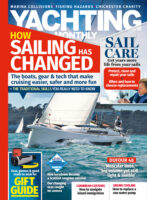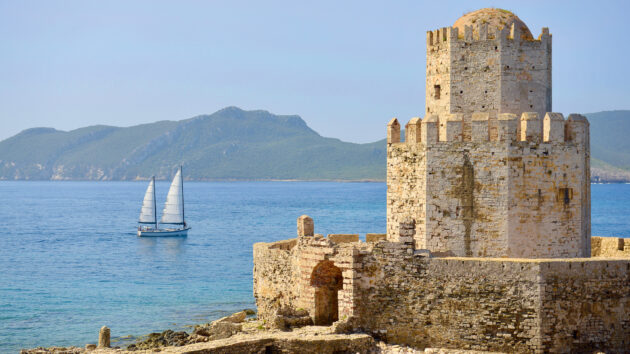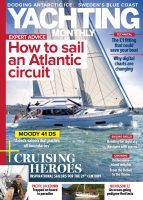Nic Compton debates whether to sail his ketch Zelda through the Corinth Canal or around the exposed coast of the Peloponnese, the entrance to the Underworld in Greek mythology
From Lefkada, on the west coast of Greece, it’s 150 miles to Aegina, on the other side of the Peloponnese, via the Corinth Canal.
You pass through the Gulf of Patras, visiting the pretty fortified town of Nafpaktos, collecting your prophecy from the oracle at Delphi, and motoring through the Corinth Canal. An easy one-week cruise.
Or you can do it the difficult way: 300 miles around the exposed south coast of the Peloponnese, passing the three capes: Akritas, Matapan and Malea. On the way, you pass countless shipwrecks, the entrance to the Underworld, ruled by Hades, and the very place where Odysseus met his downfall in a mighty storm. You then have to fight your way up the east coast of the Peloponnese, against the prevailing winds, to reach Aegina.
Night Sail
After sailing more than 2,000 miles together, bringing my Freedom 33 cat ketch Zelda from England to Greece followed by cruises to Albania and around the Ionian, the one thing I know about my regular crew – paramedic lecturer Matt, bar manager Laurence and freelance chef James – is that they are always up for a challenge. The southern route it would be.
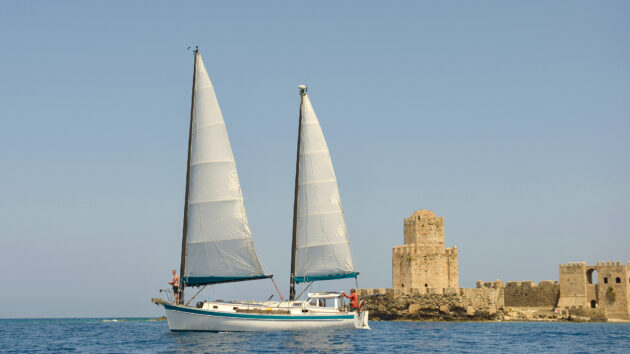
Zelda’s crew enjoy sailing past the ancient tower at Methoni
And so it was that we found ourselves bounding down the southern Ionian one windy evening at the beginning of June. With less than 10 days to get to Aegina, after which we had flights booked back to the UK, we had decided to deploy our secret weapon: night sailing. It was while sailing from France to Greece (in less than two weeks!) two years before that we had discovered how much ground we could cover by sailing overnight.
We figured that if we got some miles under our belts at the start of this voyage, we’d have more time to enjoy the bits we were really looking forward to, such as the Mani peninsula.
The wind was on the starboard quarter as we headed down the Strait of Zakynthos, and Zelda was surfing down the waves at a steady 6.5 knots, at one point hitting 7.8 on the GPS. Luckily Matt has a cast iron stomach and was able to go down below and rustle up some dinner, which he proceeded to dish up into four plastic bowls.
It was at this moment, with the lights of Zakynthos harbour looming ahead, that I decided to gybe. Big mistake. As the boom swung over and Zelda lurched to starboard, there was a crash down below and a howl came up from the galley.
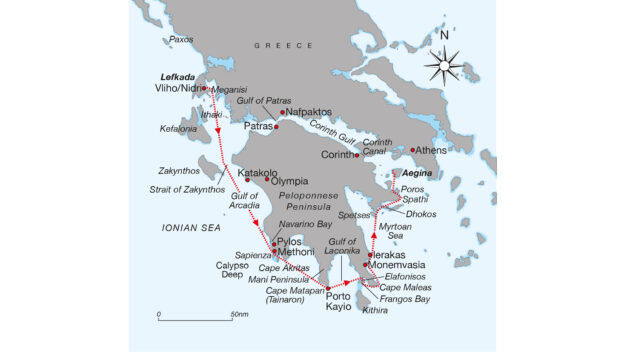
‘#$@&%*! What the #$@&%! What the #$@&%!’
It is to Matt’s eternal credit that he calmly scooped up the spillage and ate it himself, while the rest of the crew later enjoyed a hair- and dust-free meal.
Soon after dark, the wind eased and eventually died and we enjoyed a calm passage down the west coast of the Peloponnese, arriving at Methoni by mid-morning. There, thanks to Zelda’s shallow draught (just 4ft 6in), we were able to tuck inside the harbour right below the fort and perch on the end of the very shallow fisherman’s quay to fill up with much-needed water.
Even though we were just a few hours away from the well-polished jewels of the Ionian, where each day you play a game of cat and mouse with the charter flotillas, Methoni felt much more like the ‘old Greece’ I knew growing up as a child. The harbour is dominated by a large Venetian fort with an exquisite Turkish tower at the end of it – where the author of Don Quixote, Miguel de Cervantes, was held prisoner for a time, according to Rod Heikell’s Greek Waters Pilot – and a long sandy beach stretching out to the east.
The town itself is nothing very much, but wandering around the derelict ruins (entry fee €4 per person) in the late afternoon sun felt like a rare privilege, especially as we had it pretty much to ourselves.
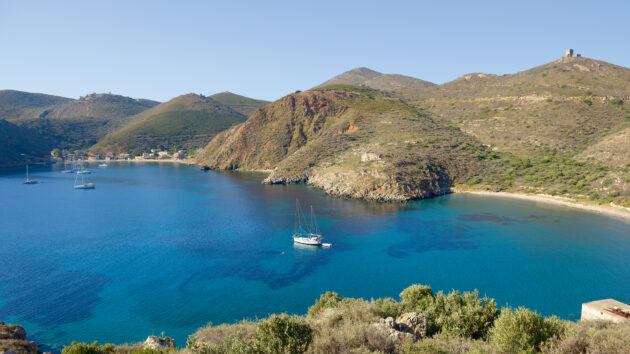
The tranquil anchorage of Port Kayio
Shipwrecks And Goats
The next day, we headed south to the island of Sapienza, which is best known as a wildlife sanctuary/hunting ground, including the famous kri-kri (Cretan goats) as well as wild sheep (mouflon), partridges, pheasants and other creatures which, for a few days a year, are allowed to be shot – be warned! But we weren’t there for the shooting, we were there for the shipwrecks – specifically a wreck said to contain 2,000-year-old red marble pillars from Palestine.
It took us a little while, but eventually we found the marble pillars: scattered across the shallow sea bed, exactly as you would have imagined them to have come spilling out of a ship being pounded on the rocks. It was a chilling sight for any sailor, and extraordinary that such ancient artefacts still lie at the bottom of the sea, within easy reach of anyone with a snorkel and flippers.
Article continues below…
It would have been wonderful to head up the Gulf of Messinia to taste my favourite olives at Kalamata and visit the travel writer Patrick Leigh Fermor’s house at Kardamyli, but our clocks were ticking and, instead, we headed straight for Cape Matapan (aka Tainaron). According to Greek legend, this is where the entrance to the Underworld is located, although, as Heikell points out, the large collapsed cave on the dramatic coast of Capo Grosso leading up to Cape Matapan would be a ‘natural choice’ for such a place.
We arrived as the sun was setting, just in time for some intense katabatic wind to come shooting down off the hills. We were in the lee of the land, so the sea was flat calm, and with full sail set, Zelda took off like a rocket, clocking up 9.7 knots on our Navionics app – not far off our all-time record of 10.1 knots, off Toulon, two years earlier.
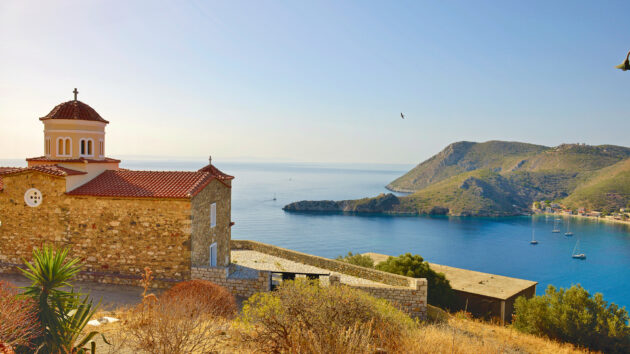
A world away from the hustle and bustle
Barren Spot
There is something end-of-the-worldish about this barren cape, with its cluster of square towers and great swathes of empty countryside. Even the village of Porto Kayio, just a few miles from the tip of the Mani, looks like a research station in a remote part of the world. I was astonished to discover (courtesy of Google Maps) that this quiet spot was only four and a half hours’ drive from Athens – about the same distance as from London to Totnes in Devon, where I live.
There were 10 other boats anchored in a line in Porto Kayio – 10 more than when I last visited this place in 1989 – but once again Zelda’s shallow draught came into its own as we anchored in a shallow bay within a bay on the western side.
I woke up early the next morning and, rather than wait for the others to get up, decided to go ashore to take some photos. I clambered up the hillside to one of those impressive Manioti towers with stunning views, but then had to scramble through a maze of prickly bushes to get back to the road – hot work especially as I’d forgotten to bring any water.
After a much-needed cappuccino freddo at the Akroti Taverna, we lifted anchor and sailed up the coast, enjoying the serenity of the silvery mountains, before turning east across the Gulf of Laconika. We were about to turn the corner into the Aegean Sea, but before that we would spend the night at the small island of Elafonisos, the traditional waiting place for yachts waiting to round Cape Maleas in bad weather.
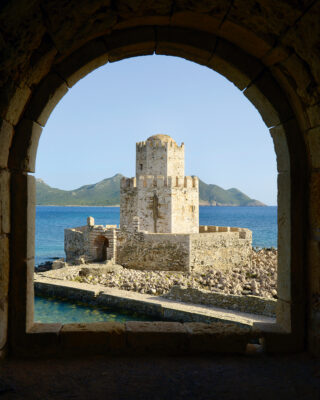
The tower at Methoni where the author of Don Quixote was imprisoned
The easy thing would have been to sail straight to the southern tip of the island, where there is an idyllic bay with a perfect sandy beach sheltered (just about) from the forecasted westerly breeze.
But once we read Heikell’s description of the shallow channel between Elafonisos and the mainland which ‘only those with iron nerve can negotiate if they so desire’, the challenge was set. It was that shallow draught thing again, and we took great pleasure in motoring across the large expanse of turquoise water, watching the depth-sounder dip down to under 2 metres in places. Heikell helpfully provides a diagram of the ‘boat passage’, and we spent a happy 20 minutes lining up his lay lines and carefully timing our crossing to miss the two car ferries that ply across the passage continuously.
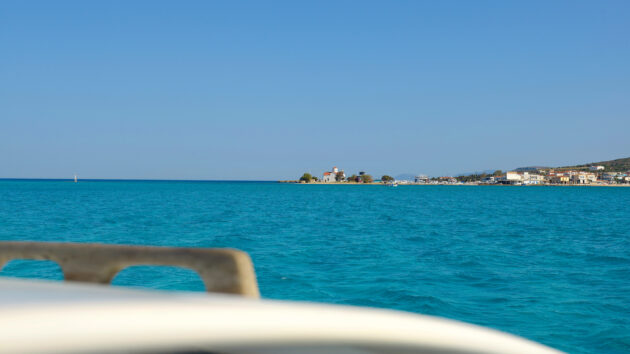
Navigating the shallow channel between Elafonisos and the mainland was a fun challenge
Blown Off Course
Our intended anchorage on the east coast of Elafonisos looked rather dull, so we ended up joining the crowd in Frangos Bay on the south coast. Sometimes you have to go with the flow.
The next day, we headed to Cap Maleas, where Odysseus was blown off course in a storm at the start of his journey, sending him off on a 10-year odyssey before he found his way home to Ithaca. We rocked up in our usual nonchalant manner, full sail set, and were promptly knocked flat by a gust shooting off the mountain side. It was short lived, but it felt as if the gods had made their point: don’t mess with Cap Maleas.
Two hours later, we were motoring up the coast across a flat calm sea, the misty mountains of the Peloponnese to starboard and a great rock looming up over the horizon, shimmering across the sea. Monemvasia is often compared to Gibraltar, and it’s true that it is a great big lump of rock jutting out into the sea with a fortified town built to one side.
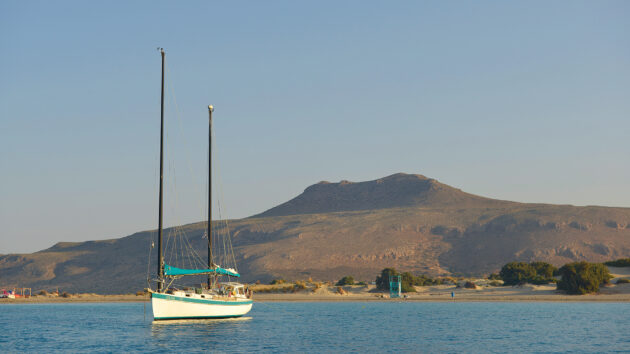
Anchored at Ormos Frangos on the island of Elafonisos, before going ‘around the corner’ into the Aegean
But whereas Gibraltar is a vibrant modern city, Monemvasia is a picturesque, carefully restored town which has remained almost unchanged since medieval times.
We moored at the small harbour at Yefira on the mainland, and crossed the man-made causeway to what was once an island. By the time we made it to the top of the winding stairs to the plateau at the top of the rock, it was evening and the Byzantine ruins were lit up with a golden light. Gazing out to sea from those 300ft high cliffs – with Crete far away to the south, the mainland to the north and the whole of the Aegean to the east – it felt as if nothing much had changed here in the past 2,000 years. Greece has that effect.
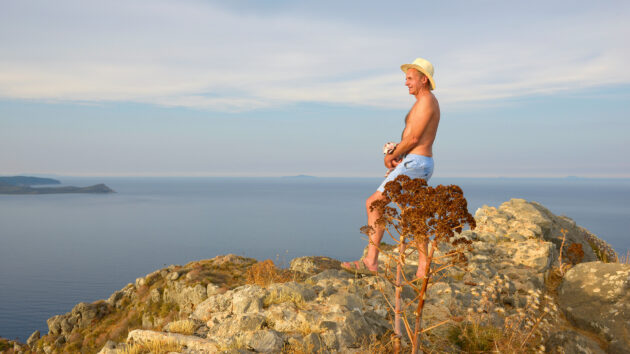
Laurence enjoys the view from the upper town of Monemvasia
Shock Return
None of us really wanted to leave the south Peloponnese, but with a Force 3-4 southerly breeze promising a perfect sail across the Myrtoan Sea, we pressed on. From the peace and tranquility of the southern Peloponnese, it was a shock to return to ‘real life’ amid the hustle and bustle of Spetses town.
So the next day we kept away from the crowds by anchoring for lunch in a quiet bay on the island of Dhokos and stopping off for the night in a deserted bay at the easternmost tip of the Peloponnese, next to the island of Spathi.
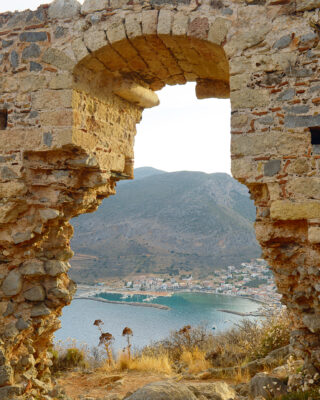
Climbing to the Byzantine ruins above the harbour at Yefira
We had been disappointed by the lack of wildlife on the voyage so far, but it all came good on our last day’s sail, from Poros to Aegina, when we came across a large pod of bluenose dolphins. Then right on cue, the afternoon wind kicked in, the sails filled and we had a fantastic beam-reach sail to the south coast of Aegina. It was time to go home.
Our journey had taken us less than 10 days to achieve what Odysseus had taken 10 years to complete, yet I couldn’t but feel that he had got the right idea. The south Peloponnese is a place you want to linger.
Enjoyed reading this?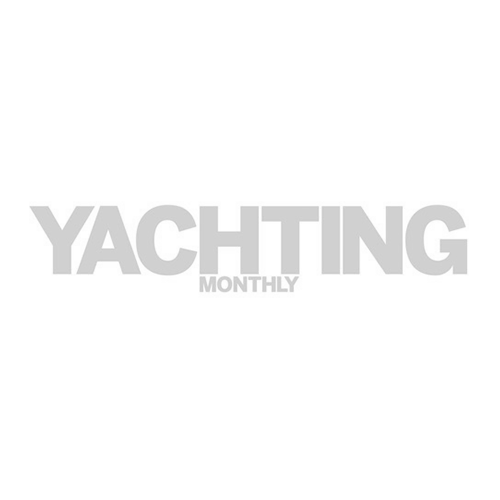
A subscription to Yachting Monthly magazine costs around 40% less than the cover price, so you can save money compared to buying single issues.
Print and digital editions are available through Magazines Direct – where you can also find the latest deals.
YM is packed with information to help you get the most from your time on the water.
-
-
- Take your seamanship to the next level with tips, advice and skills from our experts
- Impartial in-depth reviews of the latest yachts and equipment
- Cruising guides to help you reach those dream destinations
-
Follow us on Facebook, Twitter and Instagram.
Note: We may earn a commission when you buy through links on our site, at no extra cost to you. This doesn’t affect our editorial independence.

